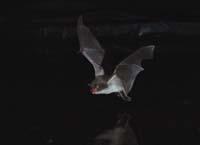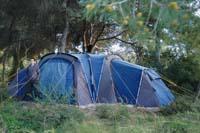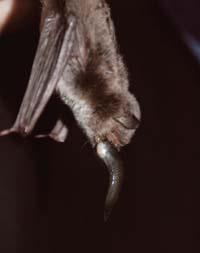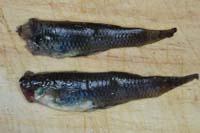Bat angler bat

Four bats were captured and studied their excrements: fish scales appeared in all of them, and also the vertebrae in some excrements. So bats ducks eat fish, but... By chance? Do they have common food? Casual? Do live fish fish fish or eat dead? Questions arose that required deeper research.

Holiday area with swimming pool
With the aim of knowing more about the fish farming of the pious bats, they prepared a research space on the mountain: a large camping shop with a well and endless food inside, and individual bedrooms for five bats, like a spa!
In the well were placed fishes of the species Gambusia holbrooki, of about 3 cm of length and about 0,25 grams. In addition, insects that are the typical food of the apple tree were also released inside the shop. In this scenario, at night, they released bats for 4.5 hours and recorded them in video with infrared light. At the end of the night, each bat was placed in his bedroom and collected his excrements to analyze them.

The bats were released on several nights and each night more fish were placed at an ever lower depth. Thus, the first night 50 fish (33.3 units/m 2) were placed in the well with a depth of 2,5 cm. The bats touched 47 times the surface with little force, but they ignored neither the waves nor the dead fish. It should be taken into account that the eco-location of bats cannot detect submarine objects, but those of surface or out of water, although they did not show interest in the waves of fish or dead fish. The insects, on the other hand, were hunted from the surface of the water. Of course, no remains of fish appeared, either in the excrements or anywhere else within the tent.
During the second and third night the concentrations of fish increased and the depth of water decreased. Thus, the third night 600 fish (400 units/m 2) were placed in waters of a single centimeter depth. That night the behavior of bats changed: 6.268 water spins, often with much force, without paying attention to dead fish. They were trying to catch live fish and, as the video explained, at least two of them fled the clutches. Subsequently, in the demolitions of the bats, scales and fish bones were found, and in several areas of the tent appeared with bones, scales and six fish heads.

Therefore, J.R. confirmed that bats capture and eat live fish. Aiartza and his team. However, it might be thought that bats would learn something for the third night.
For this reason, as control, a second group of bats (four bats) was captured which were introduced in the shop at night, and in the well, 600 fish at a depth of one centimeter. Contact with water was much lower, 829 times due to stress after capture. But, at the same time, their cynegetic behavior was similar to that shown by the previous team: they beat the surface of water again and again, putting the claws down the water with force. After the hunting session, both in the ejections of the control group and in the tent of campaign, fish remains appeared again. Thus, they affirmed that bats, in their usual activity, noticed the presence of numerous fish and began fishing.
Not just fish

Analyzing the data and recordings of images from excrements (both of bats inside the shop and outside it between 2003 and 2005) and residues, the researchers have formulated a series of conclusions and hypotheses.
The patcino bat captures fish when its density is high and/or water is very superficial. In addition, all bats used in research have the same behavior for fishing, although bats have been captured in different places. In fact, this species of bat often catches insects from the surface of the water, flying parallel to the water and using ecolocation. However, if during this process a frequent contact occurs with the claws, the waters begin to be more intense and try to capture them using a more vertical approach to water.
Likewise, they have concluded that the fishing behavior is triggered randomly by the number of involuntary contacts with the fish along the insect hunt, since the submerged can not be detected or visible with the ecolocation.
On the other hand, according to the fish found, bats eat fish from the head. This means that bats know what to do when they catch a fish. Keep in mind that birds eating whole fish, for example, swallow fish from the head, scales, bones, and fins in the throat. However, fish are not the staple food of these bats throughout the year, since rarely appear remains in the ejections.
Thus, the researchers have represented a hypothetical scenario in order to explain this fishing behavior.

The pathetic bat lives around the Mediterranean Sea, where droughts are frequent in summer. These droughts often generate small pools of river, shallow and full of fish. And as the typical food of this species are the insects of the aquatic surface, it is very common to accidentally touch fish with claws, which, in evolution, would develop the capacity of exploitation of the fish, generating a specific behavior.
Thus, the patcino bat can exploit a very abundant resource in specific conditions, but quite common, in time and in space. This scenario coincides with the research carried out in Valencia.
However, the bat manzanal is not the only bat that feeds on fish. In fact, the species Myotis vivesi and Noctilio colinus live from eating fish. In addition, there are species that occasionally consume fish. For example, it has been mentioned that the bat Daubenton ( Myotis daubentonii ) has once caught some small fish, even though it is not fully demonstrated. The latter is a species that also lives in the Basque Country.





